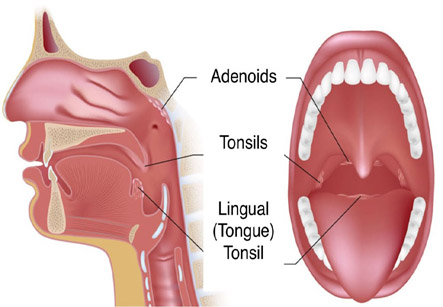Tonsillectomy
Introduction
Tonsillectomy is an operation performed to remove the two lymphoid glands in the oral cavity, and it is mostly done on children. These glands are situated at the back of the throat. Often, tonsillectomy is done at the same time as adenoidectomy, a surgery to remove the adenoid glands.
Procedure:
• The child or rarely an adult patient is given general anesthesia before surgery. This means there is no pain and patient is asleep during the procedure. The surgery is done in the hospital by a specialist Ear Nose and Throat surgeon (Otolaryngologist).
• The operation is done through the patient’s mouth. The surgeon inserts a small tool into the child’s mouth to prop it open. This instrument is called as Davis Gag and it also helps in keeping the tongue depressed.
• After this, the surgeon carefully removes the tonsils from side of the throat by scraping it away using special instruments. The surgeon may sometimes burn away the tonsils.
• Then, the doctor controls the bleeding, and the cuts heal naturally. Stitches during this procedure are very few to nil, as there are no surgical incisions involved.
We have all the information you need about public and private clinics and hospitals that provide ENT surgeries in Iran, Islamic Republic Of with the best quality and lowest possible prices

• The procedure is usually complete in about 30-45 minutes.
• Tonsils are removed alone mostly, but sometimes if found to be inflamed and infectious the adenoids are also removed using an instrument called “St Clair Thomson’s Adenoid Curette”. The operation then is called as Adenotonsillectomy.
• The child usually stays in the recovery room after surgery until fully awake and can breathe easily, cough, and swallow. Most children go home several hours after this surgery.
Indications:
The tonsils are present to protect against infections. But children with large tonsils may have repeated sore throats and ear infections. In these cases, the tonsils become seat of infection and their removal becomes necessary.
A tonsillectomy may be done in the following cases:
• Ongoing or recurring episodes of tonsillitis.
• Recurring episodes of sore throat in a single year despite antibiotic treatment.
• Abscesses of the tonsils that do not respond to drainage.
• A persistent foul odor from mouth which does not improve even after antibiotic treatment.
• A biopsy is needed to evaluate a suspected tumor of the tonsil.
• The tonsils have become so large due to infection that they affect nighttime breathing of the child, called as sleep apnea.
• Large tonsils are not a reason in itself for tonsillectomy unless they are causing one of the above problems or blocking the upper airway.
The doctor of the child may consider a tonsillectomy if:
• The child has repeated infections (seven or more times in 1 year, or five or more times over 2 years).
• The child misses a lot of school.
• The child has trouble during breathing.
• Abscess or growth on the tonsils of the child.
Risks:
The risks for any anesthesia are:
• Reactions to medications
• Breathing problems
• The risks for tonsillectomy surgery are:
• Infection
• Rarely, bleeding after surgery can go unnoticed and cause very serious problems. Swallowing a lot after surgery may be a sign of bleeding from the tonsils.
• Another uncommon risk is injury to the uvula (soft palate)
Preparation:
Your child’s doctor may ask the child to undergo:
• Blood tests (complete blood count, electrolytes, clotting factors)
• A physical examination and complete medical history
• The doctor or nurse should be informed about the drugs that the child is taking even including any drugs, herbs, or vitamins bought without a prescription.
During the days before the surgery:
• The child is asked to stop taking drugs such as aspirin, ibuprofen, naproxen and warfarin at least ten days before the surgery.
• Ask the child’s doctor which drugs should be continued even on the day of the surgery.
On the day of the surgery:
• The child is instructed to not to drink or eat anything for several hours before the surgery.
• Give the child any drugs the doctor told you with a small sip of water.
• A consent form is signed by the parents of the child regarding permission for surgery.
After the Procedure:
• A tonsillectomy is usually done in a hospital. The child can mostly go home the same day as the surgery. Rarely, there is need to stay overnight in the hospital for observation.
• Complete recovery from surgery takes about 1 to 2 weeks. During the first week, the child should avoid people who are sick and bed-ridden. In this period, it is easier for the child to become infected.
Results:
After surgery, the number of throat infections becomes progressively lower, but the child will still get some infections.